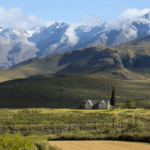The Swartberg Mountains
The Swartberg mountains are regarded as one of the “finest exposed fold mountain chains in the world. They are composed of two main mountain chains running roughly east–west along the northern edge of the Little Karoo. The two are appropriately called The Smaller and The Greater Swartberg Mountains. The smaller of the two is to the west and is in fact the higher range of peaks. This range includes the province’s highest peak, Seweweekspoortpiek (Seven Weeks Gorge Peak) at 2325 m. The famous Towerkop (Bewitch Peak) is 2189 m. The Greater Swartberg is to the east, with the dividing line between the two ranges being the Gamka River, which cuts a gorge through the mountains. The Cango caves are found within this range in the exposed limestone basement rocks exposed by upliftment along a 300 km fault
.Most of the Swartberg Mountains are above 2000 m high, making them the tallest mountains in the Western Cape mountain range is 230 km long, running from Laingsberg to Uniondale. The Swartberg Mountains are part of the Cape Fold Belt.
Until the first pass was cut, these mountains were virtually impassable. The little Karoo was cut off from the Great Karoo. In 1854, John Molteno (who later became Prime Minister) surveyed the range to cut a pass through the mountains
The Meiringspoort pass was cut and the route was completed in only 223 working days It was one of the most extraordinary feats of engineering of the time.
Today, several different passes now cut through different routes in the range. The Seweweekspoort is to the far west in the Klein Swartberge. It was built by a team of convicts without engineers and was begun in 1859. The work was finally completed in 1862. Arguably, the most beautiful 18 km stretch of gravel road anywhere in South Africa. It has easy gradients and multiple river crossings. It is a shortcut for travellers wanting to go to Ladismith or Calitzdorp from Laingsburg or Sutherland. The Route is officially called the R 323, but its official number is the P 0903
The best-known route through the mountains is the Swartberg Pass, which runs between Oudtshoorn and Prince Albert. The pass was built by Thomas Bain, son of the famous Andrew Geddes Bain, who built Bain’s Kloof Pass. It was built using convict labour and opened on 10 January 1888.
The Great Fire of 1869
The Great Fire of 1869 is regarded as South Africa’s first major fire disaster. It broke out on February 9 in the Meiringspoort area of the Swartberg Mountains and quickly swept across the Southern Cape.
Driven by a fierce berg wind, a hot, dry wind from the mountains, the fire spread rapidly over 350 kilometres. It devastated vast areas, destroying homesteads, wildlife, and plant life, and damaging the banks of the Knysna River.
The fire caused significant loss of life and property, and it left a lasting impact on the region. Millions of trees were destroyed, leaving large sections of forest severely depleted.
Remembered as a national tragedy, the Great Fire of 1869 remains an important event in local history and folklore.


